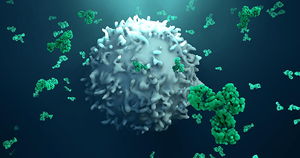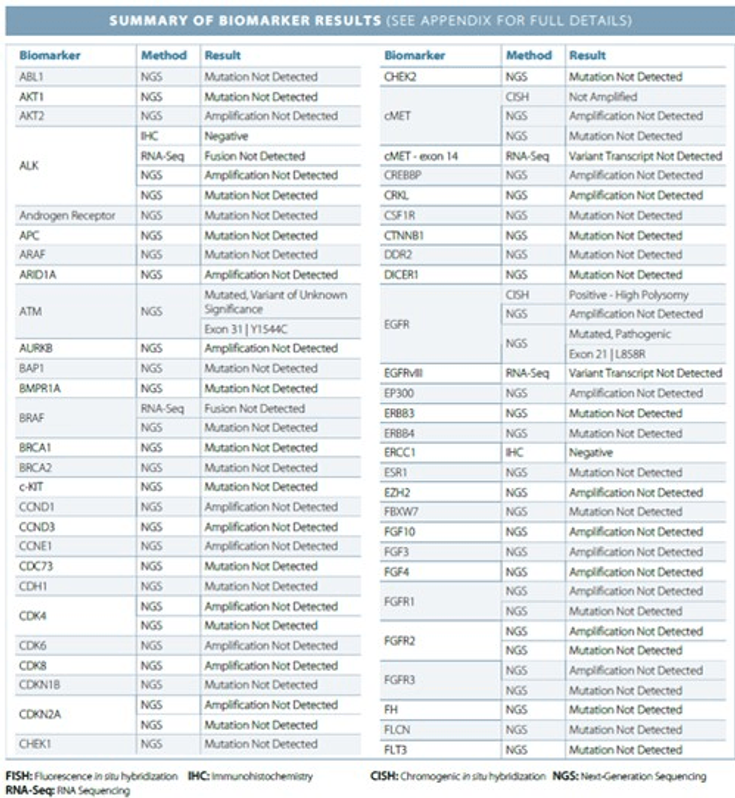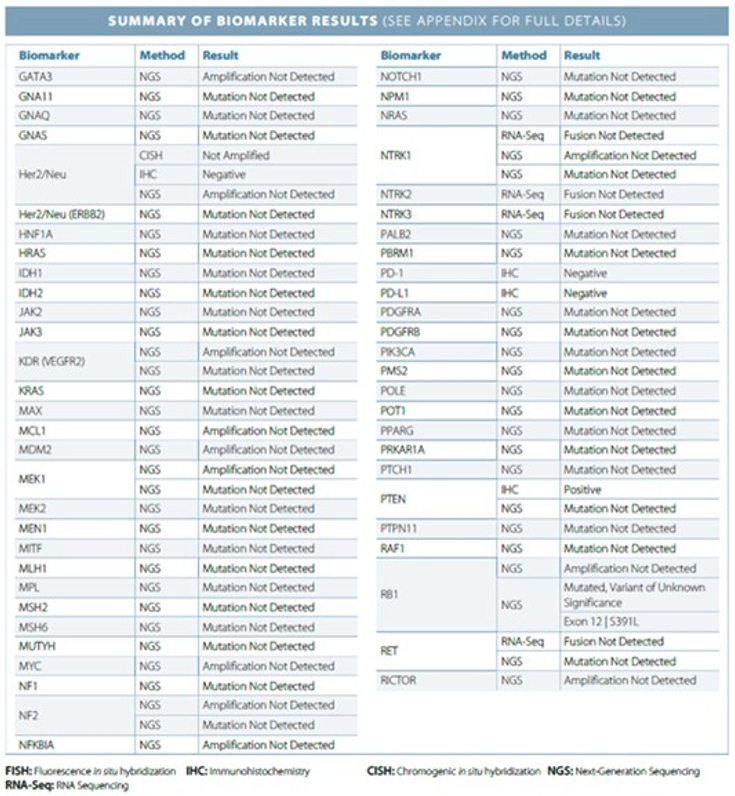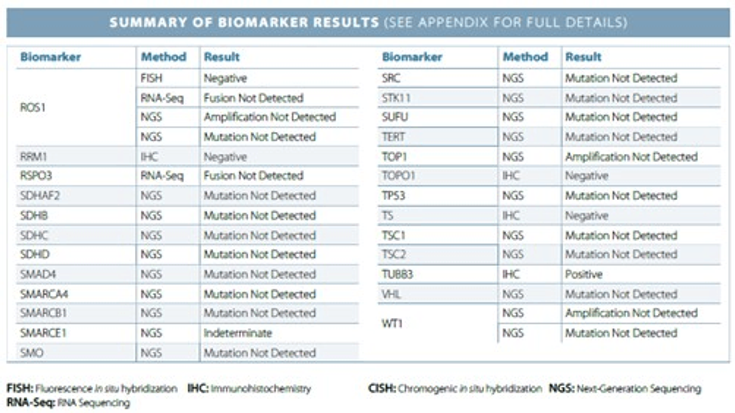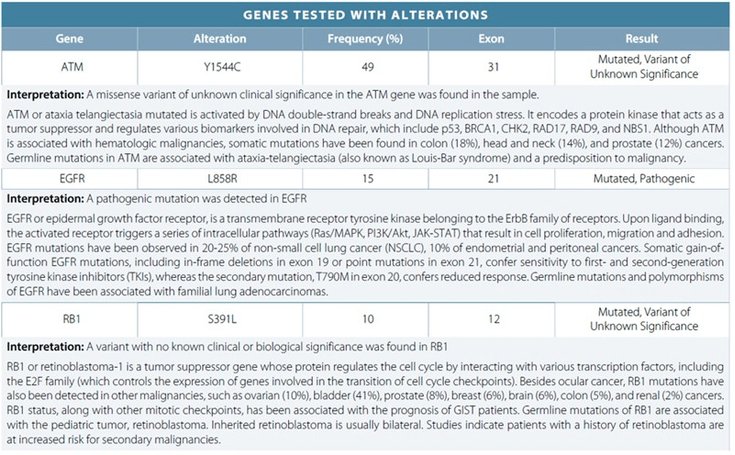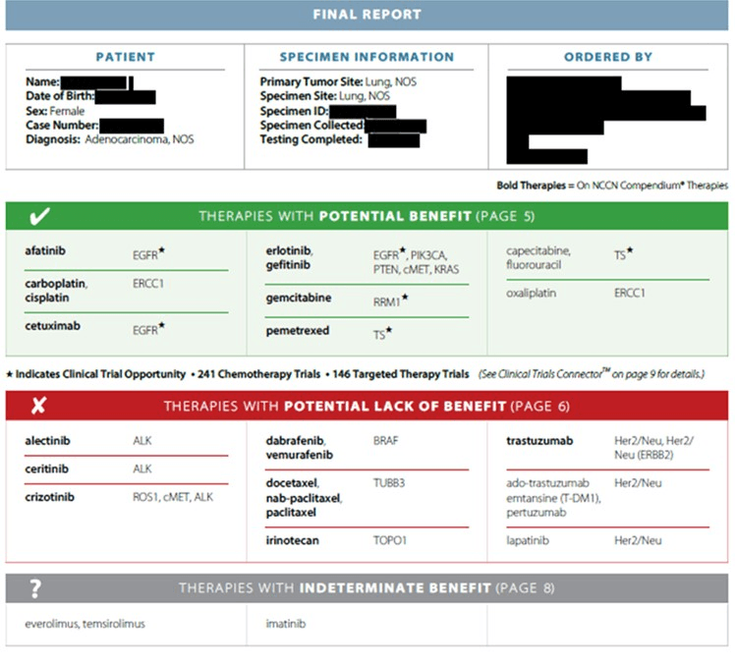Non-Small Cell Lung Cancer
Introduction
- Virtual Molecular Tumor Board
- Patient: Non-small cell lung cancer
- Carolinas HealthCare System/Levine Cancer Institute
- Presented by: Dr. Kathryn Mileham
Initial Diagnosis
A 68-year-old female never smoker developed cough that led to a CXR which was without notable abnormality in 2007. Due to lack of resolving symptoms, she underwent additional imaging.
- 9/17/07: CT chest identified a lobulated right central mass (3.2 x 3.3 cm)
- 9/26/07: PET/CT confirmed the right upper lobe mass (3.3 x 2.9 cm; mSUV 9.3) and adjacent superior hilar mass (2.5 x 2.2 cm; mSUV 8.0)
- 10/4/07: Needle core biopsy of RUL mass was pathologically consistent with TTF-1 positive, moderately differentiated adenocarcinoma
- 11/5/07: Bronchoscopy and mediastinal lymph node biopsy was also pathologically consistent with TTF-1 positive adenocarcinoma
- T2a N2 M0 stage IIIA non-small cell lung cancer was diagnosed
Treatment History
- 11/20/07 – 1/30/08: Concurrent chemoradiation with four cycles of cisplatin-navelbine
- 3/11/08…
To continue reading
Log in or register to continue reading. It's free!
OR
By signing up to create an account, I accept Healio's Terms of Use and Privacy Policy.
Introduction
- Virtual Molecular Tumor Board
- Patient: Non-small cell lung cancer
- Carolinas HealthCare System/Levine Cancer Institute
- Presented by: Dr. Kathryn Mileham
Initial Diagnosis
A 68-year-old female never smoker developed cough that led to a CXR which was without notable abnormality in 2007. Due to lack of resolving symptoms, she underwent additional imaging.
- 9/17/07: CT chest identified a lobulated right central mass (3.2 x 3.3 cm)
- 9/26/07: PET/CT confirmed the right upper lobe mass (3.3 x 2.9 cm; mSUV 9.3) and adjacent superior hilar mass (2.5 x 2.2 cm; mSUV 8.0)
- 10/4/07: Needle core biopsy of RUL mass was pathologically consistent with TTF-1 positive, moderately differentiated adenocarcinoma
- 11/5/07: Bronchoscopy and mediastinal lymph node biopsy was also pathologically consistent with TTF-1 positive adenocarcinoma
- T2a N2 M0 stage IIIA non-small cell lung cancer was diagnosed
Treatment History
- 11/20/07 – 1/30/08: Concurrent chemoradiation with four cycles of cisplatin-navelbine
- 3/11/08: PET/CT with good response, no new disease
- 9/15/09: Surveillance CT imaging suggested recurrence and PET/CT indicated new right posterior medial lower lobe lung nodule (0.9 x 1.0 cm; not metabolically active), right diaphragmatic lesion (1.3 x 1.5 cm; mSUV 2.8), and bone metastases
- 10/1/09: New biopsy was pathologically consistent with adenocarcinoma of the lung and molecular testing was positive for EGFR L858R (sensitizing mutation)
- 11/19/09: Erlotinib 150mg/day
- 11/2/11: Disease progression in lung, stable bone metastases, no metastases below the diaphragm
- 2/1/12: New biopsy was pathologically consistent with adenocarcinoma of the lung and molecular testing was positive for EGFR L858R (sensitizing) and EGFR T790M (resistant)
- 3/1/12: Enrolled and treated on clinical trial (THO-09103) with single agent afatinib 40mg/day
- 9/13/12: Disease progression in the lung, so was crossed over to afatinib 40mg/day plus cetuximab 500 mg/m2 IV Q2W
- 10/12/15: Disease progression in lung, stable bone metastases, no metastases below the diaphragm
- 11/11/15 and 11/19/15: Cetuximab and afatinib were discontinued, respectively
- 11/2/2015: Cell-free DNA from the blood had been evaluated for genomic alterations; EGFR L858R and T790M mutations were both identified
- 11/20/15: Osimertinib 80 mg/day
- 6/13/16: Disease progression in lung, stable bone metastases, no metastases below the diaphragm
- 6/20/16: New biopsy was pathologically consistent with adenocarcinoma of the lung and molecular testing was positive for EGFR L858R (sensitizing) and negative for EGFR T790M and was without small cell transformation
- 7/14/16: Erlotinib 100 mg/day
- 8/6/16: Disease progression in lung, stable bone metastases, no metastases below the diaphragm
Imaging







Pathology - Part 1




Pathology - Part 2
- Biomarker testing on 6/20/16 sample

Pathology - Part 3




Proposed potential therapies
- Summary
Discussion
- This patient’s case illustrates a decade of management for advanced EGFR-mutated adenocarcinoma of the lung.
- Although she was treated with curative intent with concurrent chemoradiation (cisplatin-based chemotherapy for four cycles), she developed biopsy-proven metastatic recurrence twenty months later.
- There was value in fresh tissue biopsies at times of progression to guide treatment recommendations.
- Because of the sensitizing EGFR mutation at L858R, she received erlotinib which resulted in a two year progression free interval.
- The L858R mutation occurs within exon 21 and is the second most common EGFR mutation in NSCLC, accounting for 40% of cases.
- This mutation results in activation of the tyrosine kinase domain and is sensitive to small molecule tyrosine kinase inhibitors such as erlotinib.
- Most patients develop resistance to first generation EGFR TKIs within 8 to 16 months of treatment.
- The mechanism of resistance in more than 50% of cases is due to the acquisition of a T790M mutation.
- Erlotinib binds in a reversible manner to the adenosine triphosphate (ATP) binding site of EGFR tyrosine kinase, inhibiting the initiation of signaling cascades.
- Afatinib is an oral irreversible ERBB family blocker that covalently binds to the cysteine residue of EGFR.
- At the time of this patient’s progressive disease, afatinib was not FDA approved.
- She was treated on an early phase trial with afatinib and maintained a response for six months.
- Although afatinib has been considered for treatment in patients who have progressed after first-line EGFR treatment, data from LUX-Lung 1 indicate that there is no improvement in median overall survival with afatinib when compared with placebo.*
- * Miller VA et al. Lancet Oncol 2012;13:528-538.
- At time of progression on the early phase trial, she was able to cross-over to the combination of afatinib plus cetuximab.
- She maintained a response for over three years.
- This combination regimen may be useful for patients who have progressed after receiving an EGFR TKI and chemotherapy.
- Based on phase Ib data, patients with T790M mutations have a similar response rate in comparison to those without the resistant mutation (32% versus 25%, p=0.341).*
- * Janjigian YY et al. Cancer Discov 2014;4:1036-1045.
- Osimertinib is an oral TKI that inhibits both EGFR sensitizing mutations and T790M mutations that was FDA approved on 11/13/2015 for the treatment of patients with metastatic EGFR T790M mutation-positive NSCLC, as detected by an FDA-approved test, who have progressed on or after EGFR TKI therapy.
- At time of progression and approval of this agent, this patient changed treatment from afatinib-cetuximab to osimertinib.
- She continued on osimertinib for six months.
- In the two studies that led to approval of osimertinib the overall response rate was 57% and 61%, and the median duration of response had not been reached. The dose finding phase of the studies showed a median DOR of 12.4 months.*
- * http://www.accessdata.fda.gov/drugsatfda_docs/label/2015/208065s000lbl.pdf
- At time of progression on osimertinib, she underwent repeat biopsy at a site of progression to assess for additional acquired resistant mutations.
- C797S is one EGFR mutation that has been identified after progression on osimertinib.
- Acquired resistance may also be associated with histologic transformation to small cell lung cancer.
- This patient had neither, but she did have loss of T790M and maintenance of the EGFR L858R mutation.
- Given that she had not received erlotinib for four and a half years and the T790M mutation was no longer identified, erlotinib was prescribed as her final therapy.
- This was well tolerated but not effective.
- Short interval imaging was consistent with progressive disease.
- She was enrolled in hospice before succumbing to her disease one month later.
This patient never received cytotoxic chemotherapy in the metastatic setting. She received targeted therapy for nearly a decade which was well-tolerated with aggressive supportive management. Her treatment adjustments were always based on fresh tissue/plasma genomic assessments.

